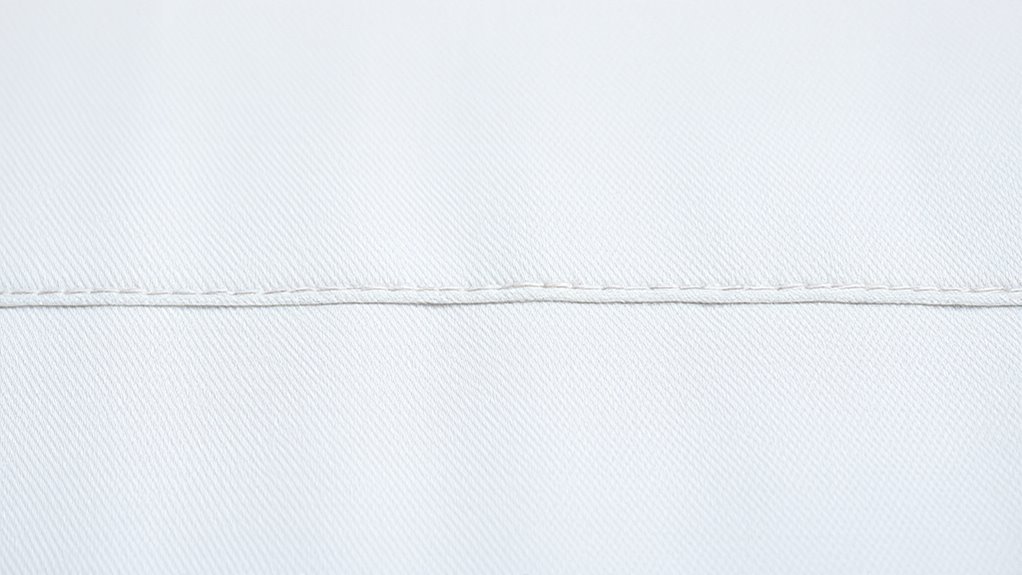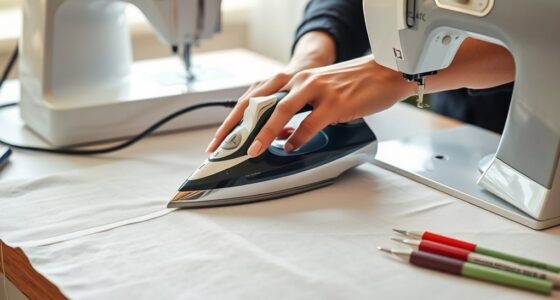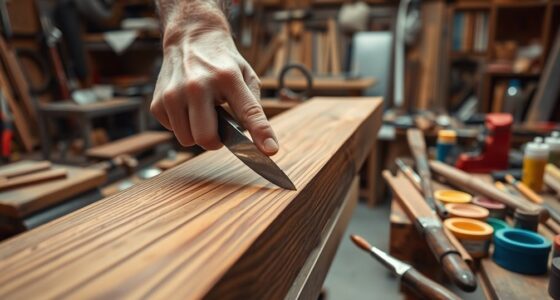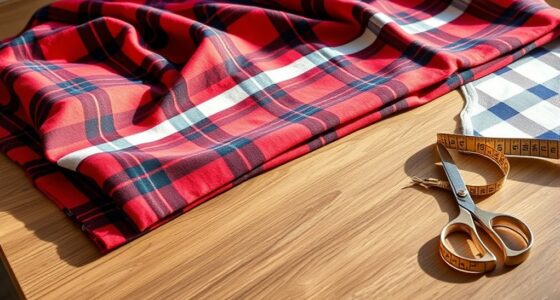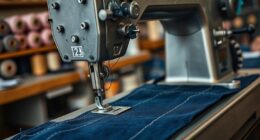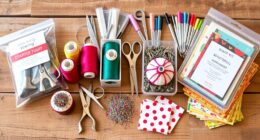To achieve flawless topstitching with even, straight lines, start by maintaining your machine—clean it regularly, check needles, and oil moving parts. Choose the right fabric and set your machine for a 3–3.5mm stitch length, testing on scraps first. Use guides or a walking foot to keep stitches straight, sew at a steady pace, and avoid pulling fabric. With proper technique and consistent practice, you’ll discover the secrets to perfect topstitching—more tips await if you continue exploring.
Key Takeaways
- Use a seam guide or presser foot edge to maintain a consistent sewing line.
- Set your machine to a suitable stitch length, around 3mm–3.5mm, for even topstitching.
- Practice on scrap fabric to perfect your control and line straightness before working on your project.
- Keep fabric steady and aligned, avoiding pulling or pushing during sewing for smooth, straight lines.
- Regularly maintain your sewing machine, including cleaning, needle replacement, and tension adjustments.
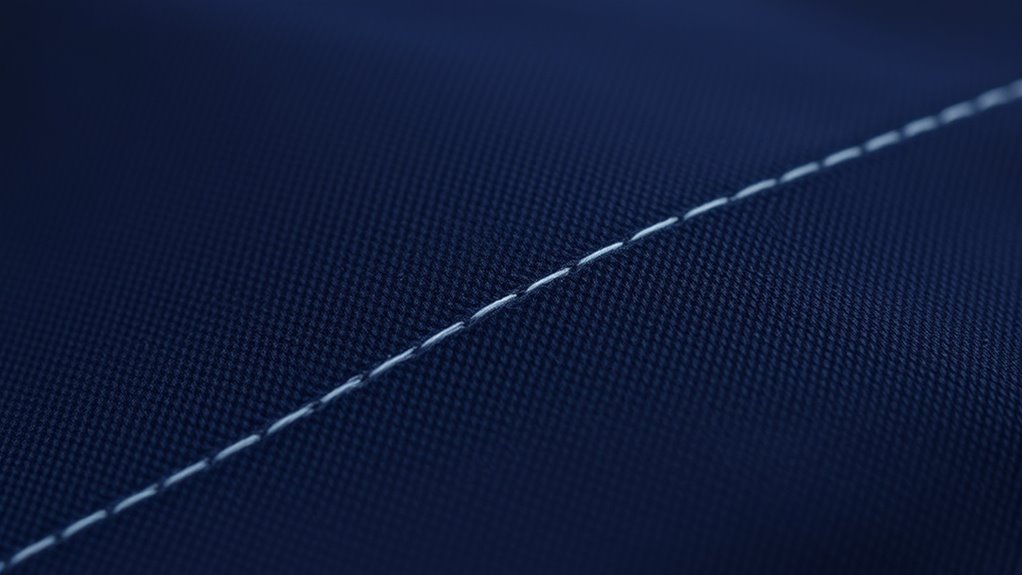
Achieving flawless topstitching can considerably elevate the look and durability of your sewing projects. To do that, you need to pay attention to a few key details, starting with your sewing machine maintenance. A well-maintained machine runs smoothly, ensuring consistent stitch length and tension. Regularly clean out lint, check your needle for dullness or damage, and oil moving parts as recommended by your machine’s manual. When your machine is in top shape, it’s easier to produce even, straight lines, which are essential for professional-looking topstitching.
Consistently maintained machines produce neat, professional topstitching with even lines and secure stitches.
Another critical factor is fabric selection. The type of fabric you choose influences how your stitches will behave and how easily you can achieve a straight, even line. Thicker fabrics like denim or upholstery material might require a stronger needle and slightly adjusted tension, while lightweight fabrics such as silk or chiffon demand a delicate touch and fine needles. Picking the right fabric helps prevent puckering, skipped stitches, or uneven tension—problems that can ruin the appearance of your topstitching.
Once you’ve covered maintenance and fabric choice, focus on your machine’s settings. Set your stitch length to a slightly longer setting—typically around 3mm to 3.5mm—so your topstitch stands out without looking bulky. Use a straight stitch or a slightly reinforced stitch, depending on your project’s needs. Test your settings on scrap fabric first; this helps you fine-tune tension and stitch quality before working on your actual project. Properly adjusted tension is essential. If stitches are puckering or loose, tweak the tension dial gradually until your stitches are even and secure.
Guidance from your machine’s seam guides can help you sew straight lines. Use the edge of your fabric aligned with the seam allowance guide on your presser foot or plate. Take your time and sew at a steady, consistent pace—rushing often leads to uneven stitching. Keep your fabric aligned and don’t pull or push while sewing; let the feed dogs do the work. For extra precision, consider using a walking foot, especially on thicker or slippery fabrics. Additionally, maintaining your sewing machine by regular servicing can prevent issues and ensure consistently flawless results.
Finally, practice is your best friend. Before working on your main project, practice on scraps to develop a steady hand and confidence. With good sewing machine maintenance, proper fabric choice, and mindful sewing techniques, you’ll find it much easier to achieve those even, straight topstitch lines that give your projects a polished, professional finish. Remember, patience and preparation go a long way toward flawless results.
Frequently Asked Questions
Can Topstitching Be Done on Stretchy Fabrics?
Yes, you can do topstitching on stretchy fabrics. To get even, straight lines, you need to adjust your sewing machine settings, like using a stretch or stretch stitch. Also, consider the fabric’s stretchability—less stretchy fabrics are easier to work with. Use a stretch needle and a zigzag stitch if needed, and sew slowly to maintain control. This way, your topstitching stays smooth and professional-looking.
What Tools Help Achieve Perfect Topstitching?
Getting topstitching just right is no walk in the park, but with the right tools, you can hit the nail on the head. Use the correct sewing machine needles suited for your fabric, and always rely on seam guides to keep your stitches straight and even. These tools act like a steady hand, guiding you to achieve professional-looking, flawless topstitching every time.
How Do I Fix Uneven Topstitching?
If your topstitching is uneven, start by checking your sewing machine settings and making tension adjustments. Verify the thread tensions are balanced on both the upper and bobbin threads. Practice on scrap fabric to fine-tune these settings before working on your project. Using consistent seam allowances and guiding the fabric smoothly through the machine also helps keep your stitches even and straight.
Is Topstitching Necessary for Durability?
Did you know that topstitching can increase garment durability by up to 50%? You might wonder if it’s necessary, and the answer depends on your project. Proper sewing machine settings and thread selection are key—topstitching reinforces seams and keeps fabrics aligned. Without it, your items may wear out faster. So, for stronger, longer-lasting pieces, incorporating topstitching is a smart move.
Can Topstitching Be Decorative as Well as Functional?
You can definitely use topstitching for both decorative and functional purposes. Embellishment techniques like decorative stitches add visual interest and personality to your project, making it stand out. Simultaneously, topstitching reinforces seams, ensuring durability. By choosing creative stitches and contrasting threads, you blend style with function, turning simple topstitching into an eye-catching detail that enhances your garment’s overall look while providing extra strength.
Conclusion
With these secrets in your toolkit, your topstitching will dance like a well-choreographed ballet—smooth, even, and confident. Embrace each stitch as a brushstroke on your fabric canvas, turning simple seams into artful lines of perfection. Remember, practice is your guiding star, lighting the way to mastery. So, keep your needle steady, your vision clear, and watch as your sewing transforms into a flowing masterpiece, one flawless line at a time.
